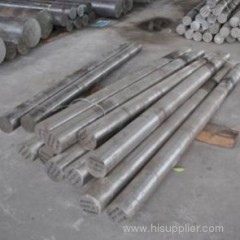
SUS201/ X12CrMnNi17-7-5
| Payment Terms: | L/C, T/T |
|---|---|
| Place of Origin: | Jiangsu |
Company Profile
| Location: | Nanjing, Jiangsu, China (Mainland) |
|---|---|
| Business Type: | Manufacturer |
| Main Products: | Stainless Steel Round Bar , Round Steel Bar , Corrosion Resistant Alloys , Maraging Steel , Austenitic Stainless Steel |
Product Description
Belong to nickel-saving steel; its property is close to 12Cr17Ni7 and it can replace 12Cr17Ni7.
The product has no magnetism in solid solution state and it has a little magnetism after cold working.
The steel is mainly used in making hotel equipment, kitchenware, pool, vehicle, etc.
Austenitic Stainless Steel is characterized by its high content of austenite-formers, especially nickel. The types within this kind are X10CrNi18-8, SUS303 and X5CrNi18-10, etc. Austenitic Stainless Steel Bar is also alloyed with chromium, molybdenum and sometimes with copper, titanium, niobium and nitrogen. Alloying with nitrogen raises the yield strength of the steels. Austenitic stainless steel is widely used in the chemical industry and the food processing industry. The molybdenum-free steel also has very good high-temperature properties and is therefore widely used in furnaces and heat exchangers.
The product has no magnetism in solid solution state and it has a little magnetism after cold working.
The steel is mainly used in making hotel equipment, kitchenware, pool, vehicle, etc.
Austenitic Stainless Steel is characterized by its high content of austenite-formers, especially nickel. The types within this kind are X10CrNi18-8, SUS303 and X5CrNi18-10, etc. Austenitic Stainless Steel Bar is also alloyed with chromium, molybdenum and sometimes with copper, titanium, niobium and nitrogen. Alloying with nitrogen raises the yield strength of the steels. Austenitic stainless steel is widely used in the chemical industry and the food processing industry. The molybdenum-free steel also has very good high-temperature properties and is therefore widely used in furnaces and heat exchangers.
Austenitic stainless steels are produced in the largest quantities (over 70% of production as 300 series). Austenitic and ferritic stainless steels are hardened and Strengthened by cold work because they are not heat treatable. Low-carbon versions, for example 316L or 304L, are used to avoid corrosion problems caused by welding.
For high-temperature boiler applications, three general grades, SUS304, SUS321, and SUS347, are the most widely used. They are all in the classification of 18% chromium, 8% nickel with some slight variations in the range of these alloying elements. Within these classifications are other grades, designated by a following capital letter, L or H. The differences are only in the carbon content.
Austenitic stainless steels have been used for several decades in high-temperature applications within a steam generator. They have excellent high-temperature tensile and creep strengths and excellent corrosion resistance. The microstructural changes during long-term operation are more subtle than in the ferritic steels.

